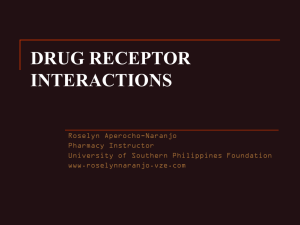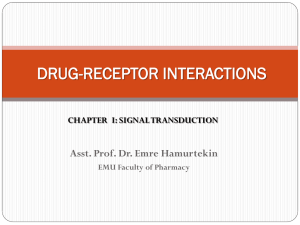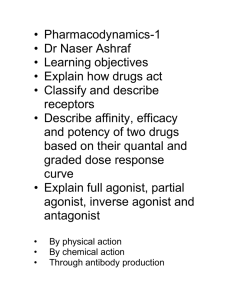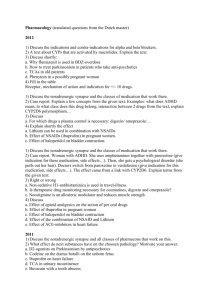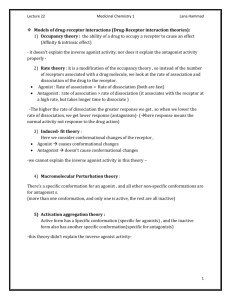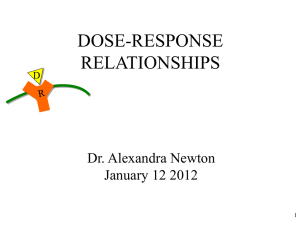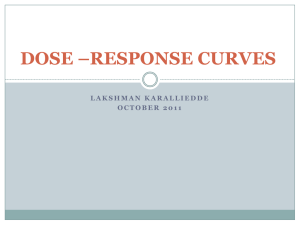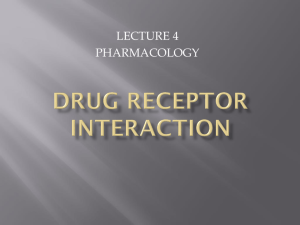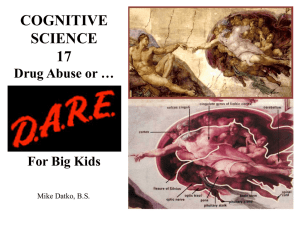Pharmacodynamics
advertisement
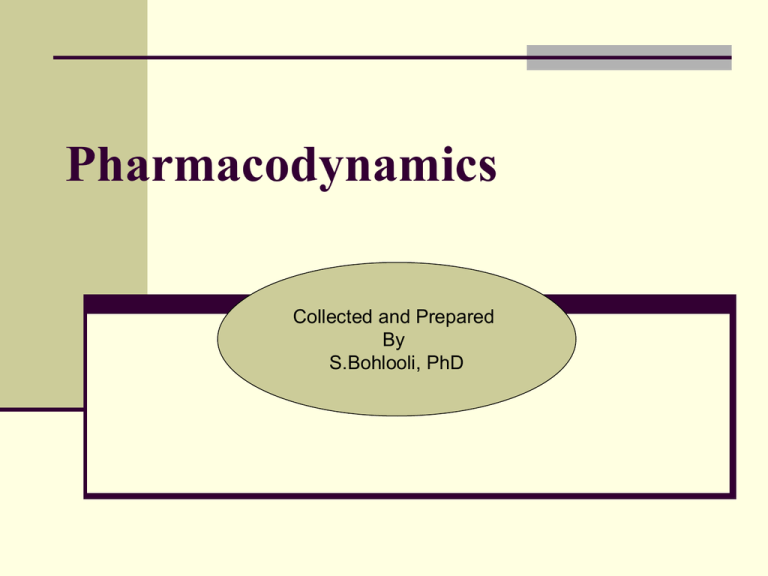
Pharmacodynamics Collected and Prepared By S.Bohlooli, PhD LOCUS OF ACTION “RECEPTORS” Bound ABSORPTION Free TISSUE RESERVOIRS Free Bound Free Drug Bound Drug SYSTEMIC CIRCULATION BIOTRANSFORMATION EXCRETION Molecular pharmacology : Molecular pharmacology is concerned with studies of basic mechanisms of drug actions on biological systems. The idea that drugs act upon specific sites (receptive substance) began with John New Port Langley (18521926) of Cambridge. However the word ‘receptor’ is given by Paul Ehrlich (1854- 19 15). The receptor concept which forms a key note in the development of molecular pharmacology became firmly established by the quantitative work of Alfred Joseph Clark (1885-1941), a professor of pharmacology at Kings College London. Receptor (key element) In addition to its usefulness for explaining biology, the receptor concept has important practical consequence for The development of drugs Arriving at therapeutic decisions in clinical practice. Receptors: Largely determine the quantitative relations between dose or concentration of drug and pharmacologic effects Are responsible for selectivity of drug action Mediate the actions of pharmacologic antagonists Macromolecular nature of drug receptors Regulatory proteins Enzymes Transport proteins Structural proteins Quantitative aspects of drug-receptor interaction Drug-Receptor Interactions Obey the Law Of Mass Action At equilibrium k1 D R DR effect k2 By law of mass action: [ D ].[ R ]. k 1 [ DR ]. k 2 Therefore: k2 k1 KD [ D ].[ R ] [ DR ] KD [ D ].[ R ] [ DR ] Total number of receptors: Rt = [R] + [DR] [R] = Rt – [DR] KD [ D ].( R t [ DR ]) [ D ]. R t [ D ].[ DR ] [ DR ] [ DR ] After rearrangement: [ DR ] [ D ]. R t [ DR ] K D [D] Rt [D] K D [D] When [D] = KD [DR] = 0.5 RT 1.00 [DR]/Rt 0.75 [ DR ] 0.50 Rt [D] K D [D] 0.25 0.00 0 5 10 [D] KD 15 20 % Bound Receptor Binding KD Concentration of Ligand The dose-response relationship (from C.D. Klaassen, Casarett and Doull’s Toxicology, 5th ed., New York: McGraw-Hill, 1996). Relation between drug dose & clinical response Drugs are described based on the magnitude of two properties: 1. Affinity for the receptor. Affinity is related to potency. 2. Efficacy once bound to the receptor. Efficacy refers to the maximal effect the drug can elicit. Agonists and Antagonists AGONIST - Has affinity for receptor and efficacy. ANTAGONIST - Has affinity but no efficacy. Competitive Antagonist Noncompetitive Antagonist Partial Agonist or Partial Antagonist – Has affinity but lower efficacy than full agonist. Receptor ligand types Full Agonists (i.e., equal efficacies) that Differ In Potency: A B C Compare the EC50s Drug Concentration (log scale) Agonists That Differ in Efficacy A % Max response B C Log Drug Concentration Full and partial agonist occupancy and response relationship 100 Response(%) Response (full agonist) Occupancy (both) 50 Response (partial Agonist) 0.0 0.01 0.1 Concentration (umol/l) 1.0 10.0 Inverse agonist Inverse agonist can exist where an appreciable level of activation may exist even when no ligand is present For example: receptors for benzodiazepines, cannabinoids and dopamine Under such condition it may be possible for a ligand to reduce the level of activation. such drugs are known as inverse agonist Competitive Antagonism Shifts The Agonist D-R Curve (Potency) AG alone EC50 AG + ANT EC50 Drug Concentration (log scale) Noncompetitive Antagonism Decreases Agonist Efficacy % Max response AG alone AG + NC ANT AG + higher dose NC ANT Log Drug Concentration Spare receptor are said to be ‘spare’ for a given pharmacological response when the maximal response can be elicited by an agonist at a concentration that not result in occupancy of the Agonist with Agonist with Agonist full complement of availablenoncompetitive receptors noncompetitive alone Respones(%) Emax Receptors antagonist in presence of spare receptor Log Concentration antagonist in absence of spare receptor Antagonist like to bind to receptor in R and R” state without any preference and makes no shifts in net equilibrium Agonist like to bind to receptor in R’ state and shifts the equilibrium toward more LR’ and makes effect R R’ L L Effect No effect LR LR’ Inverse agonist has more affinity to receptor Partial agonist has a little in R state and shifts the more affinity for receptor in R’ equilibrium toward more states than R state and makes LR and make negative partial effect response than resting state. Possible mechanism for the partial agonist phenomenon. Desensitization and Tachyphylaxis Desensitization Tolerance Refractoriness Drug resistance Changes in receptor Loss of receptor How? Exhaustion of mediators Increased metabolic degradation Physiological adaptation Active extrusion of drug from cells Drug Antagonism Pharmacologic Chemical Propranolol & norepinephrine Dimercaprol & heavy metals Pharmacokinetic Phenobarbital & warfarine Physiologic Epinephrine & histamine Signaling mechanism & drug action Type of receptors Ligand gated ion channels G protein coupled receptors Ligand-Regulated Transmembrane Enzymes Including Receptor Tyrosine Kinases Cytokine Receptors Intracellular receptors Ligand gated ion channel (iontropic receptors) -amino butyric acid (GABA) Glycine Aspartate Glutamate Acethylcholine Serotonin Ligand gated ion channel (iontropic receptors) ions R Hyper polarization or depolarization Cellular effects G protein coupled receptors Adernocorticotropic hormone Acetylcholine Angiotensin Catecholamines Chrionic gonadotropin Follicle stimulating hormone Glucagon Histamine Luteinizing Hormone Seretonin Vasopressin G protein coupled receptors Ions R + G Change in excitability Ca2+ release - + G E - Second messengers Protein phosphorylation Cell effects other Kinase linked receptors Ligand -regulated transmembrane enzyme including receptor tyrosine kinases Insulin Epidermal growth factor (EGF) Platelet-derived growth factor (PDGF) Arterial natriuretic factor (ANF) Transforming growth factor (TGF- ) Cytokine receptors Growth hormone Erythropoietin Interferones Kinase linked receptors R/E Protein phosphorylation Gene transcription Protein synthesis Cellular effects Nuclear receptors Nucleus R Gene transcription Protein synthesis Cellular effects Well Established Second Messengers Cyclic Adenosine Monophosphate (cAMP) Calcium and Phosphoinositides Cyclic Guanosine Monophosphate (cGMP) Good Luck
